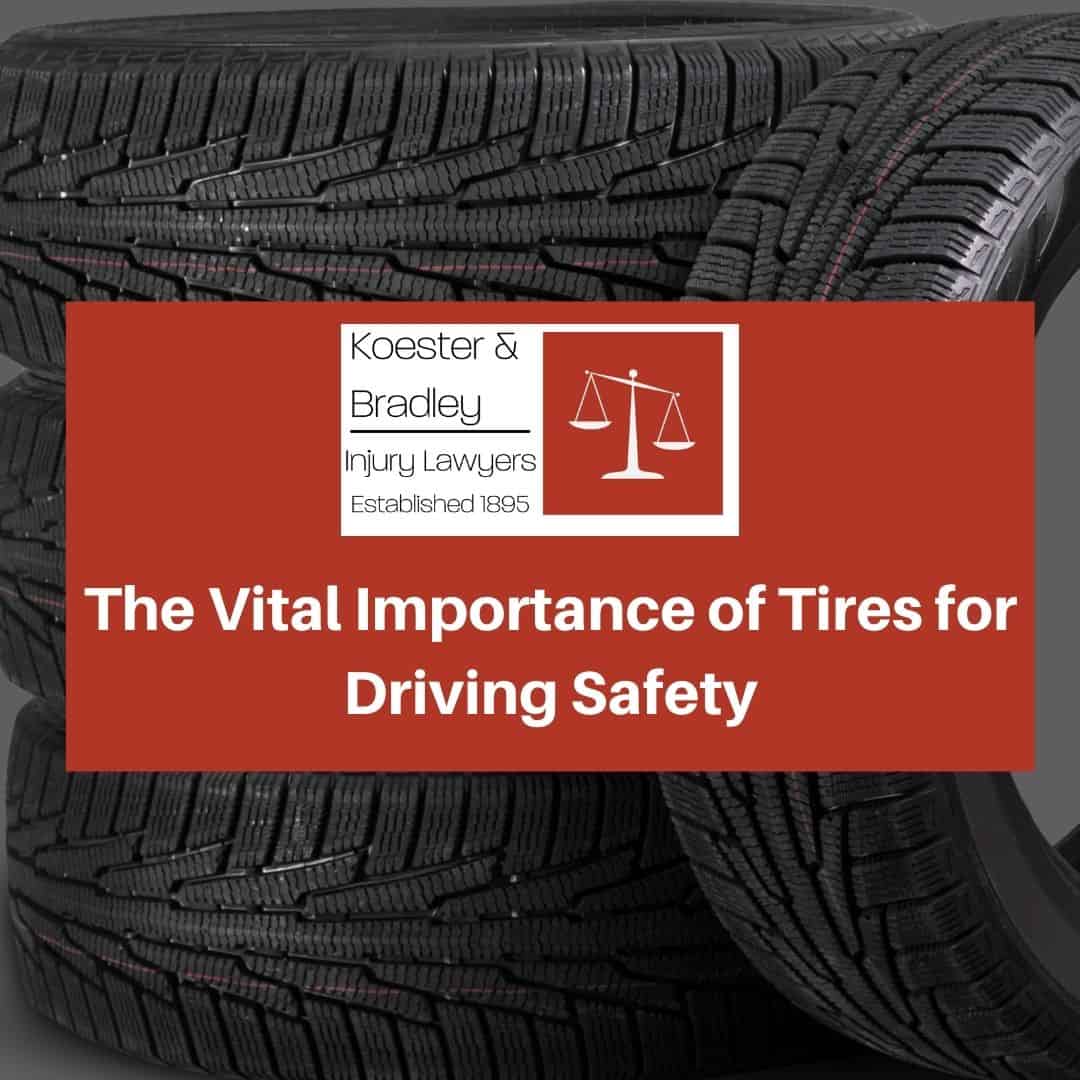- Free Personal Injury Consultation: (217) 337-1400 Tap to Call
The Vital Importance of Tires for Driving Safety

How Do Tires Impact Auto Accidents?
At Koester Law, PLLC our auto accident lawsuit team as well as our trucking accident litigators constantly see the carnage that can result from poor tire maintenance and worn out tires. It is understandable that Illinois drivers are reluctant to think about tires. A good set of tires can cost between $400 and $1,000. However when you realize that the tires on your vehicle are the sole connection that your car makes with the road, the cost seems more reasonable.
Are Your Tires Worn Out?
It is estimated that over 33,000 crashes occur each year as a result of tire degradation. Tire degradation is caused by (1) time, (2) ambient and operating temperatures, (3) flex fatigue, (4) partial pressure of oxygen in a tire and (5) constructing and compounding characteristics. Although recent tire degradation has received a great deal of recent press, it is not a new problem but one that is been studied vigorously since the 1980s. In fact, M. Pottinger wrote an article, “The Effect of Tire Aging on Force and Moment Properties of Radial Tires, in 1981 where he notes that “the physical properties of rubber such as modulus elongation, loss factors, etc. undergo significant changes over extended periods of time due to ozone, temperature, oxidation, humidity and other environmental factors.” Similarly, M.A. Jacobson addressed the aging effect tires in his 1982 article, “Accident Avoidance-How Age Deterioration Can Affect Car Safety”. He notes that the tread and sidewall rubber crack and harden due to age and exposure to sunlight, ozone, high temperatures and oxygen. A 1986 article, “The Aging of Tires – Influence on the Damage Frequency” by F. Nowakowski discussed a study of 146 tread separation failures and concluded that a correlation existed between tire age and tire failures. Nowakowski’s study advised that tires older than 6 years should be removed regardless of tread depth. A June 1988 press release from Goodyear Commercial Tire Management informed the pubic that stored tires age and can be rendered unusable just as tires left in the elements.
NHTSA & Tire Aging Tests
As a response to the Firestone tire failures, Congress asked The National Highway Traffic Safety Administration (NHTSA) in the Fall of 2000 to develop a “tire aging test” in order to evaluate the risk of failure during the life of a tire. The current regulation in 2000 only evaluated the life span and risk of new tires; tires that were already in use or were in storage were not regulated. On November 1, 2000, the Transportation Recall, Enhancement, Accountability, and Documentation (“TREAD”) Act was enacted which mandated that the NHTSA revise and update the safety standards for light-truck and passenger cars. The NHTSA reviewed the effectiveness of the current 2000 tire standards and then developed the NHTSA Tire Aging Test Development Project in 2002.
The NHTSA Tire Aging Test Development Project set out to prove two goals: (1) to understand service-related tire degradation over time and (2) to develop an accelerated, laboratory-based tire test which simulates real world tire aging and then allows the remaining structural durability of these test tires to be evaluated. The NHTSA expected that the highest level of tire degradation would take place in warmer climates and thus, Phoenix was the location chosen for the collection of on-vehicle tires. The NHTSA determined that changes in tire properties were due to two mechanisms: (1) thermo-oxidative aging and (2) cyclic fatigue during tire deformation. Thermo-oxidative aging occurs when the heat and reaction to oxygen causes the rubber compound and material interfaces of the tire to degrade. Cyclic fatigue leads to cracks and separations of the tire tread.
The NHTSA developed three methods of accelerated, laboratory-based tire testing to determine structural durability of aged tires. The first two methods (Michelin’s Long-Term Durability Endurance Test and Continental’s Passenger Endurance Test) were combined to determine tire aging and durability. Michelin’s test required the tires to be inflated to a mixture of 50% oxygen and 50% nitrogen and then run on a 1.707m roadwheel for up to 500 hours. Continental’s test required the test tires to be run on the 1.707m roadwheel under proprietary conditions for up to 240 hours. A test based on research by Ford was used for the third method which required that the test tire be inflated to a mixture of 50% oxygen and 50% nitrogen and then heated in an oven for a period of time in order to speed up the chemical reactions and test the material property changes. The heated tire was then later run on a road wheel in order to study structural durability changes.
New tires were then compared to the tires that had been aged in the laboratory setting. The NHTSA reported that over 95% of tire failures in its complaint database involved wire-coat skim compound, the tire tread and belt area, and the wire-coat wedge compound between the steel belts in the tire tread. These areas were studied in the most detail and it was found that increases occurred in the hardness, modulus, cross-link density and oxygen content. The ultimate elongation, peel adhesion and flex property also decreased over time.
The NHTSA then analyzed what variables had the biggest effect on the change in these properties. Data was then collected comparing the changes in properties to those tires taken from service in Phoenix to those tires used in the laboratory-based testing. The changes in the properties of the tire were higher in those tires used in the laboratory-based testing. The longest roadwheel test times showed the same level of change in property as the same tires used in Phoenix with a real world use of 1 to 3 years. A tire of 3 to 6 years of service in Phoenix had the same change in properties that a tire oven-aged had at the highest level. It was also found that hardness of type E, H and L tires increased during oven-aging and decreased during real world service in Phoenix or roadwheel testing in a lab setting.
Structural integrity was also tested based upon a method involving the oven-aging of tires and a stepped-up load test. Tires aged 3 weeks at 70°C had longer running times before failure than did tires aged at 60°C. C and L tires aged at 60°C at 8 weeks had no decrease in roadwheel time, despite the fact that L tires had the greatest loss in physical properties during aging tests. B and D tires had failure times below 100% load only at aging times of 8 weeks at 65°C. These same model tires had a predicted failure rate below 100% after 5 or more years of service in Phoenix. E tires used for 3 to 4 years of service in Phoenix or oven-aged for 8 weeks at 65°C produced failures below 100% of the maximum rated load for the tires. H tires used for 2 to 3 years of service in Phoenix or oven-aged from 6 to 8 weeks between 60°C and 70°C resulted in failure below 100% of the maximum rated load for the tires.
Tires: How Old Is Too Old?
The National Transportation Safety Board (NTSB) studied several aged tire-related crashes in 2014. They found that aged tires are often used well beyond safe service lives. For example, in the February 15, 2014 Centerville, Louisiana crash between a school bus and a SUV, it was determined that the SUV’s driver lost control of the car after the right rear tire’s tread separated. It was determined that the SUV’s tire was approximately 12.5 years old. The crash resulted in the death of 4 people and injuries to 34 others. The NTSB also determined that recalled tires tend to remain in service several months after a recall is issued. For example, a 15-passenger church van rolled over on February 21, 2014 in Lake City, Florida resulting in two deaths and severe injuries to several minor children. It was determined that the crash was likely caused by a left-rear tire failure. The NTSB investigation determined that that the tire had been recalled for a known safety defect approximately one and half years before the crash but had continued to remain in service.
The National Highway Traffic Safety Administration (NHTSA) estimated that tire aging may have contributed to 23% of tire-related crashes. Despite their years of research, the NHTSA has not defined what is an “appropriate” tire age but merely refers to vehicle and tiremaker recommendations. “The British Rubber Manufacturers Association (BRMA) recommended in June 2001 that tires over six years of age should not be put into service and that all tires should be replaced ten years from the date of their manufacture. However, the BRMA notes that even an inspection by a tire expert may not reveal the full extent of tire deterioration.” Ford noted in its 2006 MY owner’s manuals that “tires degrade over time, even when they are not being used on the road. It is recommended that tires generally be replaced when they are six years or older.” Chrysler’s 2006 Owner’s manuals contained a similar warning noting that “tires and spare tires older than six years could result in sudden tire failure resulting in loss of control that could lead to serious injury or death.” Tire Rack notes on its website that they believe street tires have a useful life in service of between six to ten years. It is no wonder why the general public may be confused as to when tires should be replaced.
Tire Recalls
The NTSB discovered that between 2009 and 2013, only 44% of recalled tires were actually removed from service and that only 20% of affected tires are returned to the manufacturer. Under the current recall system, tire identification numbers (TINs) are compared against TINs listed on recall notices. The problem here is that TINs are difficult to locate without the use of a professional vehicle lift because the number is listed on the inside of the tire’s mounted sidewall. Cross-referencing a TIN with an individual recall bulletin is also extremely difficult as no recall database searchable by TIN is in currently in existence. Unfortunately, this forces the consumer to rely on service shops and dealers to inform them of recalls. The NTSB has recommended the following improvements: (1) the printing of TINs on both sides of the tires, (2) requiring manufacturers to create TIN searchable recall databases on their websites, (3) requiring mandatory registration of all tires at the point of sale and (3) using radio frequency identification (RFID) chips and laser scan codes to transmit recall information. Congress recently passed “Fixing America’s Surface Transportation Act” (FAST Act) which implemented NTSB’s proposed improvements #2 and #3. However, the FAST Act does not require computerized registration or NTSB’s proposed improvement #4 which would help ensure effective communication to consumers.
Conclusion
We know that tires will continue to degrade with (1) time, (2) ambient and operating temperatures, (3) flex fatigue, (4) partial pressure of oxygen in a tire and (5) constructing and compounding characteristics. We know that tires will continue to be put into service if they appear serviceable. Finally, we know that aged tire-related crashes will continue to occur until policies and practices are created and implemented by the government.









